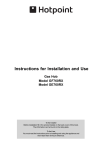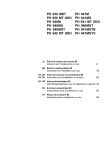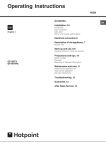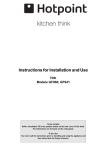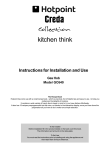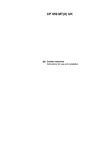Download Ariston PH 741 RQO GH AUS Specifications
Transcript
Congratualtions on choosing an Ariston appliance, which you will find is dependable and easy to use. We recommend that you read this manual for best performance and to extend the life of your appliance. Thank you. Close-up View F D I A A B B C H C C A B C A Gas Burners B Support Grid for Cookware C Control Knobs for Gas Burners and Electric Hot Plates D Ignitor for Gas Burners F Safety Device (only on certain models) - Activates if the flame accidentally goes out (spills, drafts, etc.), interrupting the delivery of gas to the burner. H Indicator Light for Ceramic Glass Module I Ceramic Glass Module (only on certain models) 12 How To Use Your Appliance The position of the corresponding gas burner or electric hot plate (if present) is indicated on each control knob. Since the burner is equipped with a safety device "F", after lighting the burner keep the knob pressed in for about 2-3 seconds to allow the device which keeps the flame lit automatically to heat up. The selected burner can be regulated using the corresponding knob, as follows: • Off Gas Burners The burners differ in size and power. Choose the most appropriate one for the diameter of the cookware being used. The burner can be regulated with the corresonding control knob by using one of the following settings: • Off High Low High Low To light the selected burner, first press the corresponding knob down fully, turn it anti-clockwise to the high flame symbol, and keep the knob pressed down until the burner ignites for approximately 2-3 seconds to allow the safety device "F", which keeps the flame lit automatically, to heat up. To turn on one of the burners, place a lighted match or lighter near the burner, press the knob all the way in and turn it anti-clockwise to the "High" setting. To turn off a burner, turn the knob clockwise until it stops (it should be on the “•” setting). Caution: If the burner accidently goes out, turn off the gas on the control knob and wait at least 1 minute before you try to to light it again. To turn off a burner, turn the knob clockwise until it stops (it should be on the “•” setting). Ceramic Glass Module (only on certain models) This cooktop is fitted with dual-ring radiant heating elements located beneath the glass. It is possible to turn on only the circular part of the elemement (identified by the letter "A") or the cooking surface can be enlarged by turning on both "A" and "B". To turn only the circular "A" element, simply turn the knob in the clockwise direction to any one of the 12 available settings. To add the "B" section, turn the knob to setting 12 and then click it into the setting. Then proceed by turning the knob in the counter-clockwise direction to one of the 12 settings. The figure shows the heating zones, which become red when the element is turned on. A. Circular heating zone; B. Extended heating zone; C. Indicator light to show when the cooking zone is above 60°C, even after the heating element has been turned off. The “separate double flame” burner This burner consists of two concentric burners which can operate either together or separately. Use of the double flame on the maximum setting gives a very high power which reduces cooking times with respect to conventional burners. Moreover the double flame crown provides a more uniform distribution of heat on the bottom of the pan, when using both burners on minimum. Pots and pans of all sizes can be used. In the case of the smaller pots and pans we recommend the use of only the internal burner. There is a separate control knob for each of the “separate double flame” burners. The knob marked by the symbol burner; B A operates the external C operates the internal The knob marked by the symbol burner. To turn on one of the rings, press the relative knob in all the When the knob is on any of the settings other than "Off", the "H" operating light comes on. way and turn it anti-clockwise to the high setting . The burner is fitted with an electronic igniter that automatically starts when the knob is pressed in. 13 How to Keep Your Cooktop in Shape Before cleaning or performing maintenance on your appliance, disconnect it from the electrical power supply. To extend the life of the cooktop, it is absolutely indispensable that it be cleaned carefully and thoroughly on a frequent basis, keeping in mind the following: · Do not use steam equipment to clean the appliance. • The enameled parts and the glass top, if present, must be washed with warm water without using abrasive powders or corrosive substances which could ruin them; • The removable parts of the burners should be washed frequently with warm water and soap, making sure to remove caked-on substances; • On cooktops with automatic ignition, the end of the electronic ignition device must be cleaned carefully and frequently, making sure that the gas holes are not clogged; • Stainless steel can be stained if it remains in contact with highly calcareous water or aggressive detergents (containing phosphorous) for an extended period of time. It is recommended that these parts be rinsed thoroughly with water and then dried well. It is also a good idea to clean up any spills; • Before using the ceramic glass module, the surface must be cleaned, using a damp cloth to remove dust or food residues. The ceramic glass surface should be cleaned regularly with a soultion of warm water and a non-abrasive detergent. Periodically, special products will need to be used to clean the surface. First, remove all food buildup or grease with a cleaning scraper, e.g. (not supplied) (Fig. A). Clean the cooking surface when it is still warm with a suitable cleaning product (such as the one in the Solutions product line available from any Merloni Elettrodomestici After-Sales Service Centre) and paper towels. Then rub with a damp cloth and dry. Aluminum foil, plastic items, objects made of synthetic material, sugar or foods with a high sugar content that have melted onto the surface must be removed immediatley with a scraper while the cooking surface is still hot. Special cleaning products for ceramic glass surfaces form a transparent protective layer which fights diry buildup. This also protects the surface from damage caused by food with a high sugar content. Do not use abrasive sponges or cleaning products under any circumstances. This holds true for chemically aggressive cleaners, like oven sprays and stain removers (Fig. B); Fig. A Fig. B Greasing the Taps The taps may jam in time or they may become difficult to turn. If so, the tap itself must be replaced. N.B.: This operation must be performed by a technician authorised by the manufacturer. Practical Advice N.B. On the models supplied with a reducer shelf, remember that this should be used only for the Double flame internal (DCDR internal) burner when you use casserole dishes with a diameter under 12 cm. To identify the type of burner, refer to the designs in the section entitled, "Burner and Nozzle Specifications". Practical Advise on Using the Burners For best performance, follow these general guidelines: • Use the appropriate cookware for each burner (see table) in order to prevent the flame from reaching the sides of the pot or pan; • Alwasy use cookware with a flat bottom and keep the lid on; • When the contents come to a boil, turn the knob to "Low". Burner Practical Advice on Using the Half Fish-Kettle Burner The two "Half Fish-Kettle" burners, are eliptic in form and can be turned up to 90°. This makes the cooktop more flexible in terms of how it can be used. ø Cookware diameter (cm) Semi-Rapid (S) 16 - 20 Auxilliary (A) 10 - 14 Half-Fishburner (SP) 16 - 20 Triple Crown (TC) 24 - 26 Double flame (DCDR internal) 10 -14 Double flame (DCDR external) 26 - 28 To turn the two burners 90°, proceed as follows: • Make sure that the burners are cool; 14 • • • Lift the burner completely out of its housing; Replace it in its housing in the position desired; Make sure that the burners are positioned correctly before use. In addition, the two burners can be used in tandem or speartely with cookware of different shapes and sizes: • Double burner for a fish-kettle or oval cookware (Fig. A). • Double burner for a griddle or rectangular/square cookware with minimum dimensions of 28x28 cm (Fig. B) • Single burner for medium size cookware (diameter of 16-20 cm) (Fig. C). • NEVER use the double burner in the configuration represented in figure D. For best performance, keep in mind the following: • All types of casseroles can be used on the ceramic glass cooking surface. However, it is important that the bottom be perfectly flat. Casseroles with thicker bottoms distribute heat more evenly. • Use cookware the diameter of which is at least as large as the cooking area so that all of the heat produced by the heating element is used. • Make sure that the bottom of the pot is always dry and clean to insure good contact between the cookware and the cooking surface. This will also increase the life of the pots and of the ceramic glass surface as well. Do not use the same cookware that you use for gas burners because the concentrated heat they produce can deform the bottom of the pot. Therefore, you will not achieve best results when using these pots on the ceramic glass surface. • Fig. A Fig. B Notice: The glue used to seal the glass surface may leave traces on the appliance. We recommend that the module be cleaned with a non-abrasive cleaner before being used the first time. During the first few hours of use, you may detect the smell of rubber; this will disappear after a short time. Fig. C Fig. D Practical Advise on Using the Ceramic Glass Module Set. Radiant Burner 0 Off 1 To melt butter and chocolate. 2 To heat liquids. 3 4 For creams and sauces. 5 6 For cooking at the boiling point. 7 8 For roasts. 9 10 For boiling large pieces of meat. 11 12 For frying. For utilising both cooking areas. 15 Is there a problem? It may occur that the cooktop does not function or does not function properly. Before calling customer service for assistance, lets see what can be done. First of all, check to see that there are no interruptions in the gas and electrical supplies, and, in particular, that the gas valves for the mains are open. The burner does not remain on when set to "Low". Check to make sure that: • The gas holes are not clogged. • There are no draughts near the cooking surface. • The minimum has been adjusted correctly (see the section entitled, "Minimum Regulation"). The burner does not light or the flame is not uniform around the burner. Check to make sure that: • The gas holes on the burner are not clogged; • All of the movable parts that make up the burner are mounted correctly; • There are no draughts around the cooking surface. The cookware is not stable. Check to make sure that: • The bottom of the cookware is perfectly flat. • The cookware is centered correctly on the burner or electric hot plate. • The support grids have not been inverted. If, despite all of these checks, the cooktop does not function properly and problem persists, call the nearest Merloni Elettrodomestici Customer Service Centre, informing them of: - The type of problem. - The abbreviation used to identify the model (Mod. ...) as indicated on the warranty. Never call upon technicians not authorized by the manufacturer, and refuse to accept spare parts that are not original. The flame does not stay lighted on the model with the safety device. Check to make sure that: • You press the knob all the way in; • You keep the knob pressed in long enough to activate the safety device. • The gas holes are not clogged in the area corresponding to the safety device. Safety Is a Good Habit to Get Into To maintain the EFFICIENCY and SAFETY of this appliance, we recommend: • call only the Service Centers authorized by the manufacturer • always use original Spare Parts • • • • - This manual is for a class 3 built-in cooktop. This appliance is designed for non-professional use in the home and its features and technical characteristics must not be modified. These instructions are only valid for the countries the symbols for which appear on the manual and the serial plate. The electrical system of this appliance is safe only when it is correctly connected to an adequate earthing system, as required by current safety standards. - Prevent children and the disabled from coming into contact or having access to the following, as they are possible sources of danger: - The controls and the appliance in general; - The packaging (plastic bags, polystyrene, nails, etc.); - The appliance, during and immediately after use given the heat generated by its use; - The ceramic glass cooking surface (if present) immediately before and after use, as the cooking surface will remain hot for at least a half hour after being turned off; - The appliance when no longer in installed (in this case, all potentially dangerous parts must be made safe). - - Improper and/or dangerous use; Obstructing the ventilation or heat dissipation slots; Allowing the power supply cord of small appliances to come into contact with the hot parts of the cooktop; Exposure to atmospheric agents (rain, sun); Using flammable liquids nearby; Using adaptors, multiple outlet plugs and/or extensions; Using unstable or deformed cookware; Leaving the electric hobs on (or the ceramic glass cooking surface) without cookware on top of them; Using the ceramic glass cooking surface (if present) as a counter top; Turning on the radiant heating elements (if present) when there is aluminum foil or plastic objects on the ceramic glass surface; Striking the ceramic glass cooking surface (if present) with pointed objects; Closing the glass top (if present) while the gas burners or electrical hot plates are still hot; Trying to install or repair the appliance without the assistance of qualified personnel. The assistance of qualified personnel must be called upon in the following cases: - Installation (in accordance with the manufacturer's instructions); - When in doubt about the operation of the appliance; - Replacement of the electrical outlet becuase it is incompatible with the plug. The following should be avoided: - Touching the appliance with wet parts of the body; - Using the appliance with bare feet; - Pulling on the appliance or the power supply cord to disconnect them from the electrical outlet; 16 Contact service centers authorized by the manufacturer in the following cases: When in doubt about the condition of the appliance after having removed the packing; - Damage to or replacement of the power supply cord; - In the case of a breakdown or malfunction: ask for original spare parts. - In the event the ceramic glass cooking surface breaks. - - It is recommended that you follow the guidelines below: - Only use the appliance to cook food, avoiding all other uses; - Check the condition of the appliance after it has been unpacked; - • Disconnect the appliance from the power supply in the event of malfunction and always before cleaning or maintenance; When not in use, disconnect the appliance from the power supply and turn off the gas valve (if present); Disconnect the appliance from the electrical supply in the event the ceramic glass cooking surface breakds. Always check to make sure that the control knobs are on the “•”/”o” setting when the appliance is not in use; Cut the power supply cord after disconnecting it from the electrical mains when you decide to no longer use the appliance. The manufacturer will not be held liable for any damages arising out of : incorrect installation or improper, incorrect or unreasonable use. Installation Instructions for built-in are not fitted with a safety device to prevent the flame from accidentally going out must have a ventilation opening twice the size otherwise required, i.e. a minimum of 200cm2 (Fig. A). Otherwise, the room can be vented indirectly through adjacent rooms fitted with ventilation ducts to the outside as described above, as long as the adjacent rooms are not shared areas, bedrooms or present the risk of fire (Fig. B). The following instructions are directed at the qualified installer so that the installation and maintenance proceedures may be followed in the most professional and expert manner possible. Important: Unplug the electrical connection before performing any maintenance or regulation upkeep work. Positioning for gas hob Important: this unit may be installed and used only in permanently ventilated rooms according to the British Stancards Codes Of Practice: B.S. 6172 / B.S. 5440, Par. 2 and B.S. 6891 Current Editions. The following requirements must be observed: Detail A a) The room must be fitted with a ventilation system which vents smoke and gases from combustion to the outside. This must be done by means of a hood or electric ventilator that turns on automatically each time the hood is operated. Adjacent Room Room to be Vented A Examples of ventilation holes for comburant air. Enlarging the ventilation slot between window and floor. Fig. A Fig. B c) Intensive and prolonged use of the appliance may necessitate supplemental ventilation, e.g. opening a window or increasing the power of the air intake system (if present). In a chimney stack or branched flue. d) Liquidified petroleum gases are heavier than air and, as a result, settle downwards. Rooms in which LPG tanks are installed must be fitted with ventilation openings to the outside in order to allow the gas to escape in the event of a leak. Therefore, LPG tanks, whether empty or partially full, must not be installed or stored in rooms or spaces below ground level (cellars, ect.). It is also a good idea to keep only the tank currently being used in the room, making sure that it is not near sources of heat (ovens, fireplaces, stoves, etc.) that could raise the internal temperature of the tank above 50°C. Directly to the Outside (exclusively for cooking appliances) b) The room must also allow for the influx of the air needed for proper combustion. The flow of air for combustion purposes must not be less than 2 m3/h per kW of installed capacity. The supply of said air can be effected by means of direct influx from the outside through a duct with a inner cross section of at least 100 cm² which must not be able to be accidentally blocked. Those appliances which Installation of built-in stove tops The appliance can be installed next to furniture units which are no taller than the top of the cooker hob. The wall in direct contact with the back panel of the cooker must be made of non-flammable material. During operation the 17 600mm min. Front Hook position for Back H=20mm top N.B: Use the hook contained in the "accessoires set" f) The hob can only be installed above built-in ovens provided with cooling ventilation. g) In the event the cooktop is not installed above a builtin oven, a wood panel must be inserted as insulation. This panel must be placed at least 20 mm from the bottom of the cooktop itself. Important: When installing the hob above a built-in oven, the oven should be placed on two wooden strips; in the case of a joining cabinet surface, remember to leave a space of at least 45 x 560 mm at the back. 540mm min. 700mm min. back panel of the cooker could reach a temperature of 50°C above room temperature. For proper installation of the cooker, the following precautions must be taken: a) The hob may be located in a kitchen, a kitonen/diner or bed sitting room, but not in a bathroom or shower room. b) The furniture standing next to the unit, that is higher than the working boards, must be placed at least 600 mm from the edge of the board. c) The cabinets should be positioned next to the hood at a height of at least 420 mm (Fig. C). Fig. C d) Should the hob be installed directly under a cupboard, the letter should be at least 700mm (millimetres) from the worktop, as shown in Fig. C. e) The dimensions of the room for the furniture must be those indicated in the figures in the last two pages of the cover. Fixing hooks are provided which allow to place the hob plate on work tops that measure from 20 to 40 mm in thickness (see Fig. D). To obtain a good fixing of the hob plate it is advisable to use all the hooks supplied. m. m 560 45 m m. 55 mm 475 Gas connection for gas hob The cooker should be connected to the gas-supply by a corgi registered installer. During installation of this product it is essential to fit an approved gas tap to isolate the supply from the appliance for the convenience of any subsequent removal or servicing. Connection of the appliance to the gas mains or liquid gas must be carried out according to the prescribed regulation in force, and only after it is ascertained that it is adaptable to the type of gas to be used. If not, follow the instructions indicated in the paragraph headed “Adaptation to different gas types”. In the case of connection to liquid gas, by tank, use pressure regulators that conform to the regulation in force. Important: For safety, for the correct regulation of gas use and long life of the appliance, ensure that the gas pressure conforms to the indications given in table 1 “Nozzle and burner characteristics”. mm 555 mm Fig. D Hook position for H=30mm top Hook position for H=40mm top Connection to non-flexible tube (copper or steel) Connection to the gas source must be done in such a way as to not create any stress points at any part of the appliance. The appliance is fitted with an adjustable, "L" shaped connector and a gasket for the attachment to the gas supply. Should this connector have to be turned, the gasket must be 18 replaced (supplied with the appliance). The feeding connector of the gas to the appliance is threaded 1/2 gas male cylinder. Adapting the Cooktop for Different Types of Gas To adapt the cooktop to a different type of gas than that for which it was designed, (see the sticker under the hob or on the packaging), the burner nozzles must be changed, as follows: • Remove the pan supports and slide the burners out of the cooktop. • Unscrew the nozzles using a 7mm socket wrench and replace them with those for the new type of gas. (See table 1, “Burner and Nozzle Specifications”). • Reassemble the parts following the instructions in reverse order. • On completing the operation, replace the old rating label with the one showing the new type of gas; the sticker is available from our Service Centres. If the gas pressure is different than that prescribed, a pressure regulator must be installed at the source, in compliance with national standards governing the use of piped gas regulators. Connection to flexible steel tube The gas feed connector to the appliance is a threaded, male 1/2" connector for round gas pipe. Only use pipes and sealing gaskets that that conform to the standards currently in force. The maximum length of the flexible pipes must not exceed 2000 mm. Once the connection has been made, ensure that the flexible metal tube does not touch any moving parts and is not crushed. Check the Seal Once the appliance has been installed, make sure all the connections are properly sealed, using a soapy water solution. Never use a flame. Electrical Connection The cooktops fitted with a tripolar electrical supply cord are designed to be be used with alternating current according to the indications on the rating plate located under the cooktop. The earthing wire can be identified by its yellow-green colour. In the case of installation over a built-in electric oven, the electrical connections for the cooktop and oven should be independent, not only for safety purposes, but also to facilitate removal of one or both in the future. Replacing the nozzles on separate “double flame “ burners: • remove the grids and slide the burners from their housings. The burner consists of 2 separate parts (Fig. E and fig. F); • unscrew the burers with a 7 mm wrench spanner. The internal burner has a nozzle, the external burner has two (of the same size). Replace the nozzle with models suited to the new type of gas (see table 1). • replace all the components by repeating the steps in reverse order. Electrical Connection for Gas Cooktop Fit the supply cord with a standard plug for the demand rate indicated on the rating plate or connect it directly to the electrical mains. In the latter case, a single pole switch must be placed between the appliance and the mains, with a minimum opening between the contacts of 3 mm in compliance with current safety codes (the earthing wire must not be interrupted by the switch). The power supply cord must be positioned so that it does not reach a temperature in excess of 50°C above room temperature at any point. Before actual connection make sure that: • The fuse and electrical system can withstand the load required by the appliance; • That the electrical supply system is equiped with an efficient earth hook-up according to the norms and regulations prescribed by law; • That the plug or switch are easily accessible. Important: the wires in the mains lead are coloured in accordance with the following code: Green & Yellow - Earth Blue - Neutral Brown - Live As the colours of the wires in the mains lead may not correspond with the coloured markings identifying the terminals in your plug, proceed as follows: Connect the Green & Yellow wire to terminal marked “E” Fig. E Fig. F Regulation of Air Supply to the Burner The burners do not need a primary air regulator. Minimum Regulation Minimum regulation: • Turn the gas valve to minimum. • Remove the knob and turn the regulator screw clockwise until the flame becomes small but regular. N.B.: In the case of liquid gas, the regulation screw must be fully screwed in (clockwise). or or coloured Green or Green & Yellow. Connect the Brown wire to the terminal marked “L” or coloured Red. Connect the Blue wire to the terminal marked “N” or coloured Black. 19 • Make sure that, when the knob is turned rapidly high to low, the flame does not go out. • In the event of a malfunction on appliances with the security device (thermocouple) when the gas supply is set at minimum, increase the minimum supply levels using the regulator screw in Fig. A - B. Once the adjustment has been made, apply sealing wax, or a suitable substitute, to the old seals on the by-pass. 20 Burners and Nozzle Specifications Table 1 Burner Liquid Gas Diameter (mm) Thermal power kW (p.c.s.*) By-Pass 1/100 Nozzle 1/100 Natural Gas Flow* g/h Nozzle 1/100 Nomin. Ridot. (mm) (mm) *** ** (mm) Flow* l/h Semi Fast (S) 75 1,90 0,40 30 70 138 136 106 181 Auxiliary (A) 55 1,00 0,40 30 50 73 71 79 95 Triple Crown (TC) 130 3.25 1.30 57 91 236 232 133 309 Semi-Fishburner (SP) — 1,50 0,70 41 60 109 107 88 143 Double flame (DCDR internal) 30 0,90 0,40 30 44 65 64 70 86 Double flame (DCDR external) 2 nozzle 130 4,10 1,30 57 70 298 293 114 390 28-30 20 35 37 25 45 Supply Pressures * ** *** Nominal (mbar) Minimum (mbar) Maximum (mbar) At 15°C and 1013 mbar-dry gas Propane P.C.S. = 50,37 MJ/kg Butane P.C.S. = 49,47 MJ/kg Naturale P.C.S. = 37,78 MJ/m3 20 17 25 S DC SP A PH 760 RF PH 760 RF GH This appliance conforms with the following European Economic Community directives: - 73/23/EEC of 19/02/73 (Low Voltage) and subsequent modifications; - 89/336/EEC of 03/05/89 (Electromagnetic Compatibility) and subsequent modifications; - 90/396/EEC of 29/06/90 (Gas) and subsequent modifications; - 93/68/EEC of 22/07/93 and subsequent modifications. S DC TC A PH 750 RT GH S DC A PH 741 RQO GH 21 75











